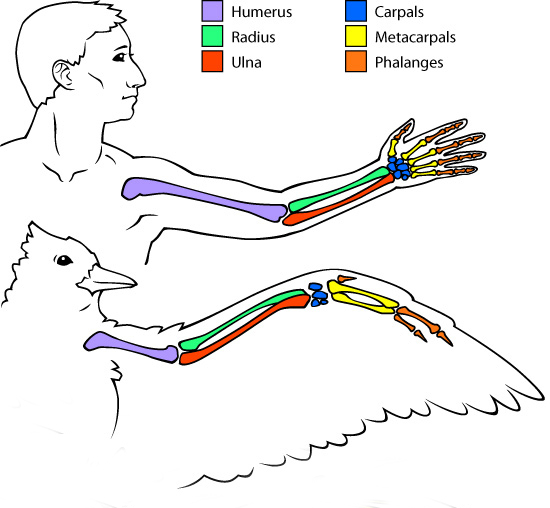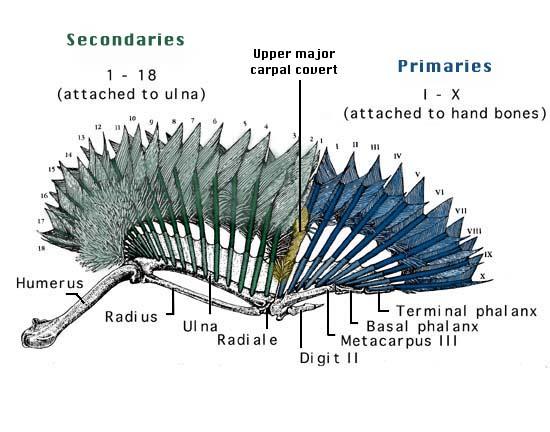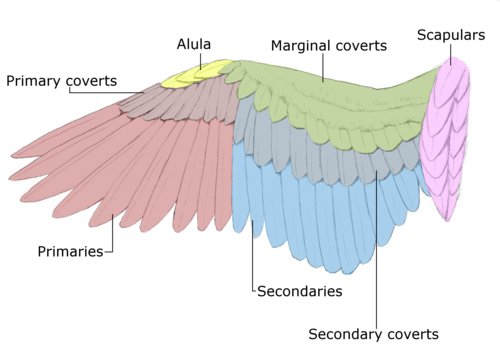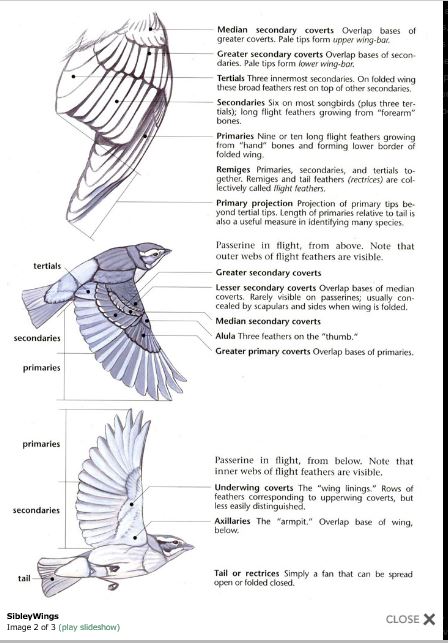Wings of a bird is like arms of a human being. The structure of the wing resembles that of the Human Arm.
The parts are Scapula, Humerus, Radius and Ulna, Carpus and Metacarpus, and the Phalanges.

These parts can be grouped as
Shoulder : consisting of the scapula (shoulder blade), coracoid (projecting part of the shoulder blade), and humerus (upper arm).
Elbow : The humerus joins the radius and ulna (forearm) to form the elbow.
Wrist : The wrist bones, carpus and metacarpus are fused together forming the carpometacarpal and the digits (fingers) are fused together in three digits.
The Alula (thumb) is also known as the “bastard wing” and moves independently of the rest of the wing

The bird’s body is covered by Feathers. There are three kinds of feathers
Flight feathers : Used in assisting the bird to fly . There are two types of flight feathers
Remiges & Coverts : They cover the wings
Retrices : they are the feathers in the tail
Filoplumes : . They are scattered through out the body especially around the CONTOUR feathers. When the CONTOUR feathers are disturbed these DOWN feathers act as pressure and vibration sensors , They make the bird aware that the CONTOUR feathers are out of place and need to be corrected
Down feathers. : To regulate the body heat and protect the body
(For a exploring further details on feathers pls refer http://ogaclicks.com/wordpress/feathers-usp-of-birds/)
Wing Feathers : These feathers have a solid rigid centre called Rachis and soft side parts called Barbs
The feathers on the wing can be classified as Remiges & Coverts
Remiges :
The remiges are the flight feathers and consist of
- Primaries ( outermost remiges)
- Secondaries ( the innermost remiges)
- Tertiaries.
These feathers make up a large portion of the shape of the wing, so much so that the length and shapes of the primaries and secondaries are used as field marks to identify different species of birds .

Primary Feathers: The Primary Feathers are the “fingertip” feathers of the wing and are found at the wingtip. Primaries are connected to the Manus (the bird’s “hand”); these are the longest and narrowest of the remiges and they can be individually rotated. These feathers are especially important for flapping flight .The outermost primaries—those connected to the phalanges—are sometimes known as pinions
Species vary somewhat in the number of primaries they possess.
- non-passerines generally have between 9 and 11
- Grebes, Storks and Flamingos have 12
- Ostriches have 16
Secondary Feathers: Secondary Feathers make up the back edge of the wing closer to the body. They are generally shorter and closer together than primaries, and birds do not manipulate them as much as they do their primary feathers. Secondaries are connected to the Ulna. In some species, the ligaments that bind these remiges to the bone connect to small, rounded projections, known as Quill knob, on the ulna; in other species, no such knobs exist. Secondary feathers remain close together in flight (they cannot be individually separated like the primaries can) and help to provide lift by creating the air foil shape of the bird’s wing. Secondaries tend to be shorter and broader than primaries, with blunter ends .
They vary in number from 6 in Hummingbird to as many as 40 in some species of Albatross. In general, larger and longer-winged species have a larger number of secondaries
Many Birds are missing the fifth secondary feather on each wing, a state known as diastataxis
Tertiary Feathers :Tertiaries arise in the brachial region and are not considered true remiges as they are not supported by attachment to the corresponding bone, in this case the humerus. These elongated “true” tertiaries act as a protective cover for all or part of the folded primaries and secondaries, and do not qualify as flight feathers as such. The term humeral is sometimes used for birds such as the albatrosses and pelicans that have a long humerus.
Coverts
Coverts are, as their name suggests, feathers that cover the wings. These feathers can visually be broken up into several groups. The arrangement of these feather groups is similar across all species of flight birds even though the shape of individual feathers varies . Often when trying to identify a bird by appearance, birdwatchers will use attributes of these feather groups (such as colour and shape) to tell one bird from another. Within each group, feathers grow in orderly rows, overlapping like shingles on a roof, and plumage patters tend to follow the contours of these feather groups .These feather groups are primaries, secondaries, greater primary coverts, greater secondary coverts, median secondary coverts, lesser secondary coverts, and alula.

Source : Wikipedia, Beat About the bush -Birds by Trevor Carnby